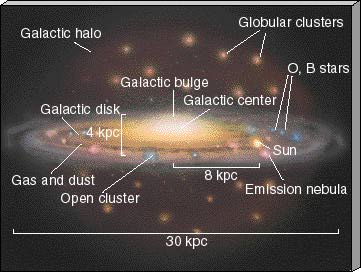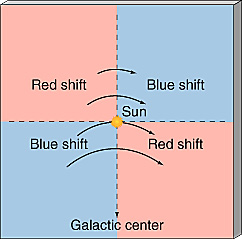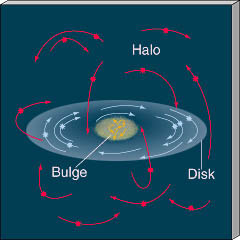Figure 23.10 illustrates the very different spatial distributions of the disk and halo components of the Milky Way Galaxy. As just mentioned, the Sun lies about 8 kpc from the Galactic center. Based on optical, infrared, and radio observations of stars, gas, and dust found within a thousand or so parsecs of the Sun, astronomers estimate that the disk in the vicinity of the Sun is relatively thin—"only" 300 pc thick, or about 1/100 of the Galactic diameter. Don't be fooled, though. Even if you could travel at the speed of light, it would take you 1000 years to traverse the thickness of the Galactic disk. The disk may be thin compared with the Galactic diameter, but it is huge by human standards.

Figure 23.10 Artist's conception of a (nearly) edge-on view of the Milky Way Galaxy, showing the distributions of young blue stars, open clusters, old red stars, and globular clusters.
Actually, the thickness of the Galactic disk depends on the kinds of objects measured. Young stars and interstellar gas are more tightly confined to the plane than are stars like the Sun, and solar-type stars in turn are more tightly confined than are older K- and M-type dwarfs. The reason for this is that stars form in interstellar clouds close to the disk plane but then tend to drift out of the disk over time, mainly due to their interactions with other stars and molecular clouds. Thus, as stars age, their abundance above and below the disk plane slowly increases. Note that these considerations do not apply to the Galactic halo, whose ancient stars and globular clusters extend far above and below the Galactic plane. As we will see in a moment, the halo is a remnant of an early stage of our Galaxy's evolution and predates the formation of the disk.
Recently, improved observational techniques have revealed an intermediate category of Galactic stars, midway between the old halo and the younger disk, both in age and in spatial distribution. Consisting of stars with estimated ages in the range of 7—10 billion years, this thick disk component of the Milky Way Galaxy measures some 2—3 kpc from top to bottom. Its thickness is also too great to be explained by the slow drift just described. Like the halo, it appears to be a vestige of our Galaxy's distant past.
Also shown in Figure 23.10 is our Galaxy's central bulge, measuring roughly 6 kpc across in the plane of the Galactic disk by 4 kpc perpendicular to the disk plane. Obscuration by interstellar dust makes it difficult to study the detailed structure of the Galactic bulge in optical images of the Milky Way (see, for example, Figure 18.5, which would clearly show a large portion of the bulge were it not for interstellar absorption). However, at longer wavelengths, which are less affected by interstellar matter, a much clearer picture emerges (Figure 23.11; compare with Figure 23.3b). Detailed measurements of the motion of gas and stars in and near the bulge imply that it is football shaped, about half as wide as it is long, with the long axis of the football lying in the Galactic plane.

Figure 23.11 A wide-angle far-infrared image of the disk and bulge of the Milky Way Galaxy, as observed by the Cosmic Background Explorer (COBE) satellite.
Aside from their shapes, the three components of the Galaxy—disk, bulge, and halo—have several other properties that distinguish them from one another. First, the halo contains essentially no gas or dust—just the opposite of the disk and bulge, in which interstellar matter is common. Second, there are clear differences in both appearance and composition between disk, bulge, and halo stars. Stars in the Galactic bulge and halo are found to be distinctly redder than stars found in the disk. Observations of other spiral galaxies also show this trend—the blue-white tint of the disk and the yellowish coloration of the bulge are evident in Figures 23.2(a) and 23.3(a).
All the bright, blue stars visible in our sky are part of the Galactic disk, as are the young open star clusters and star-forming regions. In contrast, the cooler, redder stars—including those found in the old globular clusters—are more uniformly distributed throughout the disk, bulge, and halo. Galactic disks appear bluish because main-sequence O and B blue supergiants are very much brighter than G, K, and M dwarfs, even though the dwarfs are present in far greater numbers.
The explanation for the marked difference in stellar content between disk and halo is this: whereas the gas-rich Galactic disk is the site of ongoing star formation and so contains stars of all ages, all the stars in the Galactic halo are old. The absence of dust and gas in the halo means that no new stars are forming there, and star formation apparently ceased long ago—at least 10 billion years in the past, judging from the types of halo stars we now observe. (Recall from Chapter 20 that most globular clusters are thought to be between 10 and 12 billion years old.) (Sec. 20.5) The gas density is very high in the inner part of the Galactic bulge, making this region the site of vigorous ongoing star formation, and both very old and very young stars mingle there. The bulge's gas-poor outer regions have properties more similar to those of the halo.
Support for this picture comes from studies of the spectra of halo stars, which indicate that these stars are far less abundant in heavy elements (that is, elements heavier than helium) than are nearby stars in the disk. In Chapter 21 we saw how each successive cycle of star formation and evolution enriches the interstellar medium with the products of stellar nucleosynthesis, leading to a steady increase in heavy elements with time. (Sec. 21.5) Thus, the scarcity of these elements in halo stars is consistent with the view that the halo formed long ago.
Astronomers often refer to young disk stars as Population I stars and to old halo stars as Population II stars. The idea of two stellar "populations" dates from the 1930s, when the differences between disk and halo stars first became clear. The names are something of an oversimplification, as there is actually a continuous variation in stellar ages throughout the Milky Way Galaxy, not a simple division of stars into two distinct "young" and "old" categories. Nevertheless, the terminology is still widely used.
Now let's turn our attention to the dynamics of the Milky Way Galaxy—that is, to the motion of the stars, dust, and gas it contains. Are the internal motions of our Galaxy's members chaotic and random, or are they part of some gigantic "traffic pattern"? The answer depends on our perspective. The motion of stars and clouds we see on small scales (within a few tens of parsecs of the Sun) seems random, but on larger scales (hundreds or thousands of parsecs) the motion is much more orderly.
As we look around the Galactic disk in different directions, a clear pattern of motion emerges (Figure 23.12). Radiation received from stars and interstellar gas clouds in the upper right and the lower left quadrants of Figure 23.12 is generally blueshifted. At the same time, the interstellar regions sampled in the upper left quadrant and the lower right quadrant are redshifted. In other words, some regions of the Galaxy (in the blueshifted directions) are approaching the Sun, while others (the redshifted ones) are receding from us.

Figure 23.12 Stars and interstellar clouds in the neighborhood of the Sun show systematic Doppler motions. This information tells us that the disk of the Galaxy is spinning in a well-ordered way. These four Galactic quadrants are drawn (as dashed lines) to intersect at the Sun, not at the Galactic center, because it is from the viewpoint of our own planetary system that the observations are made. The longer the arrow, the greater the angular speed of the disk material. Because the Sun orbits faster than stars and gas at larger radii, we are drawing away from material at top left and gaining on that at top right, resulting in the Doppler shifts indicated. Similarly, stars and gas in the bottom left quadrant are gaining on us, while material at bottom right is pulling away.
Careful study of the data leads to the conclusion that the entire Galactic disk is rotating about the Galactic center. In the vicinity of the Sun, the orbital speed is about 220 km/s. At the Sun's distance of 8 kpc from the Galactic center, material takes about 225 million years—an interval of time sometimes known as 1 Galactic year—to complete one circuit. At other distances from the center the rotation period is different—shorter closer to the center, longer at greater distances—that is, the Galactic disk rotates not as a solid object but differentially. Similar differential rotation is observed in Andromeda (and, in fact, in all other spiral galaxies).
This picture of orderly circular orbital motion about the Galactic center applies only to the Galactic disk. Stars in the Galactic halo and bulge are not so well behaved. The old globular clusters in the halo and the faint, reddish individual stars in both the halo and the bulge do not share the disk's well-defined rotation. Instead, their orbits are largely random.* Although they do orbit the Galactic center, they move in all directions, their paths filling an entire three-dimensional volume rather than a nearly two-dimensional disk. At any given distance from the Galactic center, bulge or halo stars move at speeds comparable to the disk's rotation speed at that radius but in all directions, not just one. Their orbits carry these stars repeatedly through the disk plane and out the other side. Figure 23.13 contrasts the motion of bulge and halo stars with the much more regular orbits of stars in the Galactic disk. Some well-known stars in the vicinity of the Sun—the bright giant Arcturus, for example—are actually halo stars that are "just passing through" the disk on orbits that take them far above and below the Galactic plane.
* (Halo stars do, in fact, have some net rotation about the Galactic center, but the rotational component of their motion is overwhelmed by the larger random component. The motion of bulge stars also has a rotational component, larger than that of the halo but still smaller than the random component of stellar motion in the bulge.)

Figure 23.13 Stars in the Galactic disk move in orderly, circular orbits about the Galactic center. In contrast, halo stars have orbits with largely random orientations and eccentricities. The orbit of a typical halo star takes it high above the Galactic disk, then down through the disk plane, then out the other side and far below the disk. The orbital properties of bulge stars are intermediate between those of disk stars and those of halo stars.